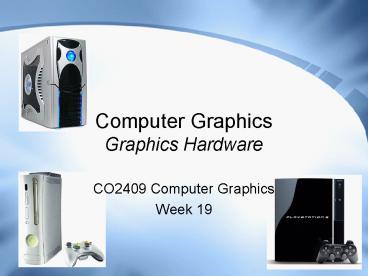Computer Graphics Graphics Hardware - PowerPoint PPT Presentation
1 / 13
Title:
Computer Graphics Graphics Hardware
Description:
The graphics unit describes the graphics processing components of a system ... E.g. number of simultaneous vertex / pixel operations (ROPs - Raster Operation Process) ... – PowerPoint PPT presentation
Number of Views:172
Avg rating:3.0/5.0
Title: Computer Graphics Graphics Hardware
1
Computer GraphicsGraphics Hardware
- CO2409 Computer Graphics
- Week 19
2
Lecture Contents
- Graphics Architecture
- Processing
- GPU vs CPU
- Memory
- Video Memory vs System Memory
- Graphics Unit Specifications
- Interface
- Custom vs AGP vs PCI Express
- Concurrency
3
Graphics Architecture
- The basic graphics architecture for all modern
PCs and game consoles is similar
- Two key parts
- Main System
- Graphics Unit
- 1 Processor each
- Local RAM for each processor
- Fast access
- Interface between components slow
- Compared to local access
4
Graphics Unit
- The graphics unit describes the graphics
processing components of a system - PC usually a separate graphics card
- Console built-in custom components
- The core of a graphics unit is the Graphics
Processing Unit (GPU) - Properly called a Graphics Adapter
- Equivalent of a CPU for graphics
Xbox 360 GPU
5
Graphics Unit
- The graphics unit also contains
- Local RAM (a.k.a. video memory, VRAM, etc.)
- Output sockets for monitor, TV etc.
- Can be integrated into the motherboard
- Consoles, some PCs and laptops
- Or attached via an interface
- Recent PC cards use AGP or PCI Express sockets
NVidia 9600 Graphics Card
6
GPU vs CPU
- A GPU is a dedicated graphics processor for a PC
or game console - Usually highly parallel
- i.e. Can run many processes simultaneously
- Much faster than CPU for graphics algorithms
- Particularly vector/matrix operations
- All modern GPUs have a programmable core pipeline
(shaders) - Power of a GPU is measured by its
- Clock speed
- Parallelism. E.g. number of simultaneous vertex /
pixel operations (ROPs - Raster Operation Process)
7
Graphics Memory
- Many graphics units have local memory
- To store vertices, primitives and textures for
the GPU - This memory is similar to standard CPU memory
- Usually more closely coupled to the GPU
- I.e. Bandwidth to the GPU will be greater
- Graphics memory can be measured by
- Clock speed (how fast can it serve data)
- Bandwidth to the GPU (speed of the bus between
graphics memory and the GPU) - Some GPUs have no dedicated memory
- Must share memory with the CPU
- This can be a benefit or a penalty
8
Graphics vs System Memory
- GPUs can usually access system memory
- i.e. CPU-local memory
- Bandwidth is often lower
- Usually better to have graphics data in GPU memory
- System memory can be used as a back-up
- But expect lag if relied on too heavily
- Some architectures share CPU GPU memory
- Xbox 360 entire console architecture designed
around this sharing performance is high - On-board video cards Lack of GPU memory is
cost-cutting feature memory access is slow
9
Graphics Unit - Specifications
- The key specifications for a graphics unit are
- GPU clock speed (MHz ) speed of processor
- Amount of Memory (Mb)
- Memory clock speed (MHz / GHz)
- GPUlt-gt Memory Bandwidth (GB / s)
- Speed of transfers between GPU and local memory
- Other factors to take into account
- Pixel / Texture Fill Rate (Giga-Pixels / s)
- Speed of drawing (textured) pixels
- Amount of parallelism in the pipeline
- E.g. Number of pixel (shader) pipes how many
pixels can be calculated at the same time
10
Specs Comparison (Indicative)
11
GPU / System Interface
- Try to keep graphics data local to the GPU
- But the CPU and system memory still need to
interface with the graphics unit - To get data into the graphics memory
- To issue instructions to the GPU (DrawPrimitive)
- For dynamic geometry / textures
- So the interface between the graphics unit and
the rest of the system is critical - Games consoles have the graphics unit built into
the motherboard and so are closely coupled - E.g. Xbox 360, PS3 have fairly symmetrical
performance between GPU, CPU memory
12
PC Graphics Interfaces
- PCs have two key graphics interfaces
- AGP (Accelerated Graphics Port)
- Shares some CPU memory with the GPU (AGP
Aperture) - Various speeds (1x to 8x) up to 2 GB/s transfer
- PCI Express (newer)
- Uses serial lanes to transfer streams of data
in parallel - Double AGP bandwidth (theoretical)
- Both slow compared to local GPU memory
- PCs must rely on more graphics memory
13
Concurrency
- GPU operates in parallel with the CPU
- And the GPU is parallel internally
- This is a concurrent system and we need to
program it as such - Try to ensure both CPU and GPU working all the
time - Neither should be waiting for the other to
complete its current task - Has implications about how we should program
graphics applications - Games students will see this in the 3rd year

